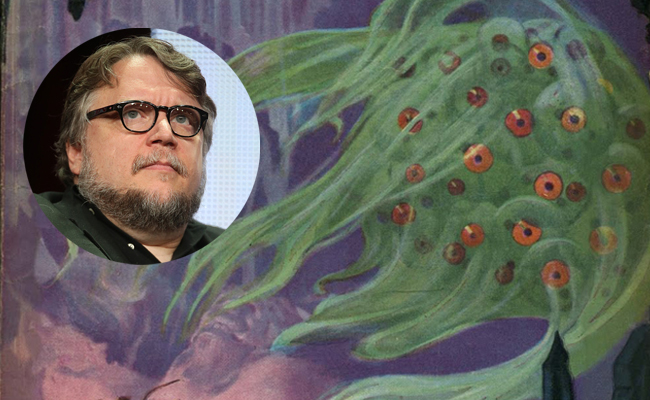
“Wise men told him his simple fancies were inane and childish, and even more absurd because their actors persist in fancying them full of meaning and purpose as the blind cosmos grinds aimlessly on from nothing to something and from something back to nothing again…” -H.P. Lovecraft
It doesn’t take long to see the effect that H.P. Lovecraft, whose birthday is today, has had on the horror movie genre, from silent films like Call of Cthulhu to directors like Stuart Gordon to John Carpenter, who both loosely adapt his work and pay homage to the larger, darker themes in his stories, respectively. Looking at the films of groundbreaking horror icon Guillermo del Toro, however, you can see echoes of him everywhere — from the vampires in Blade II, the massive kaiju in Pacific Rim, to the Pale Man in Pan’s Labyrinth, Lovecraft’s profound influence is obvious.
While del Toro has proven that that influence goes beyond a stylistic nod, we’ve talked before about the very un-Hollywood like structure to Lovecraft’s stories, making proper adaptations seemingly impossible. Having long been deemed impossible to film, not only given the cost of filming a period piece set in the Antarctic in the 1930s, but because of what would be required to make The Elder Things convincing beyond state-of-the-art special effects. Lovecraft’s creatures are horrifying to the point that the human mind cannot comprehend them, which obviously makes a big screen translation seem difficult, to say the least.
Of course, del Toro’s desire to make Lovecraft’s At The Mountains Of Madness into a movie has become the very definition of a passion project, a project he’s carried with him for the better part of a decade since co-writing a script with Matthew Robbins in 2006. Warner Bros. was the first studio to pass on the mega-budget horror movie even though Tom Cruise was del Toro’s front-runner for the lead with James McAvoy and Chris Pike also being discussed. While the star power seemed to legitimize the project’s chances, the big win was having James Cameron’s name attached as a producer.
The project then moved to Universal Studios, with plans moved forward to shoot the film in 3D. Cameron called their pre-production work “phenomenal, both the three-dimensional and two-dimensional design work, the physical maquettes, the CG test scenes; the artwork is phenomenal.” Along with his enthusiasm, Cameron was also reportedly playing it hands-off, stating clearly that he was just “there to facilitate [del Toro’s] vision.”
Yet problems arose as Universal began pushing for a more traditionally happy ending, something Lovecraft’s stories are famous for not having. They also began to insist on a PG-13 rating, given its massive budget, which del Toro felt would compromise the integrity of Lovecraft’s novella. “I think the R should be worn like a badge of merit in promoting the movie,” del Toro said in 2011, stating that his interpretation isn’t gory or violent, but, true to Lovecraft’s novella, rather intense, making a PG-13 rating seemingly impossible without compromising his vision.
With a budget of around $150 million granted to him by Universal, it was widely speculated the movie would have needed to gross close to $500 million at the box office to make a profit, which del Toro was more than confident in. He’d go on to say “with 3D, Tom Cruise, Jim Cameron, the scope of Lovecraft’s novel that is one his best regarded and most widely known works, I would venture that it could absolutely have been done.” Universal felt differently and passed on the project in 2011.
It was only after having moved on to Legendary Pictures, where he showed what he could do with a big Hollywood budget with Pacific Rim, that interest in his adaptation for At The Mountains of Madness began to recirculate once more, with del Toro’s vision remaining intact. “I don’t want to make a movie called At the Mountains of Madness. I want to make this movie.”
However, in the summer of 2012, with the release of Ridley Scott’s Prometheus — a film that had a lot in common with Lovecraft’s original novella what with its expedition to an unknown land where ancient beings responsible for both humanity’s birth and very possibly its destruction — del Toro glumly proclaimed that the film would “probably mark a long pause – if not the demise – of ATMOM.”
It would seem that pause is nearing its end, though, as del Toro has developed a newfound willingness to compromise, stating last year that he “could do it PG-13 now.” Is that a sign that the finished product will be compromised? Not necessarily. More and more it seems like the line between PG-13 films and R-rated films grows thinner and thinner, so maybe Del Toro is just observing that trend, though it would be hard to blame him even if he did move an inch to climb this particular mountain. After all, his latest movie, Crimson Peak, which he dubbed a “gothic romance,” took eight years to get off the ground, so maybe he’s just eager to put a stop to another long courtship, make Mountains of Madness in a way that is as close to his vision as is possible, and then move on to something more. Until such a time as cameras start rolling, though, del Toro’s odyssey continues. Same as it does for Lovecraft fans who want to see the impossible become possible.






